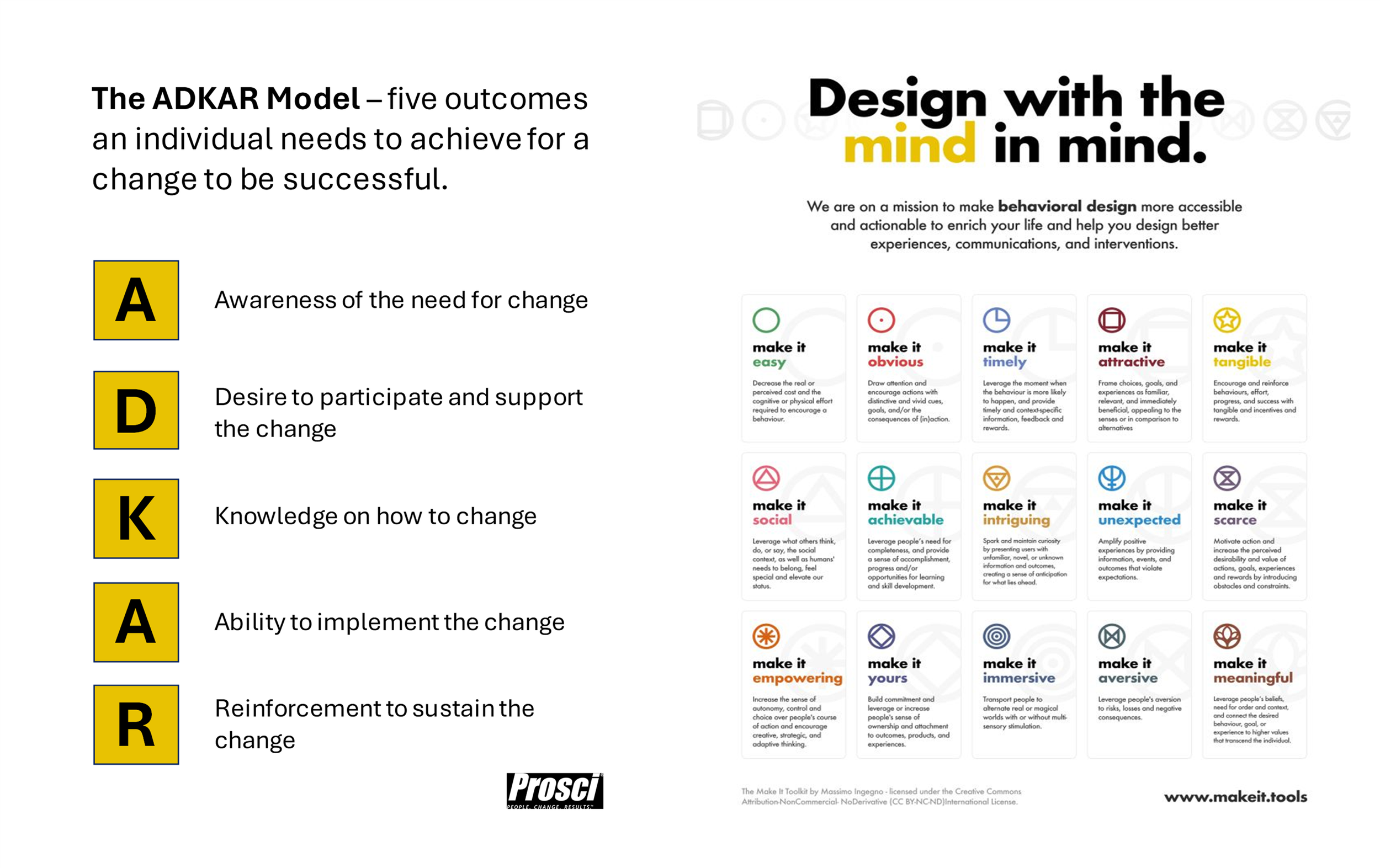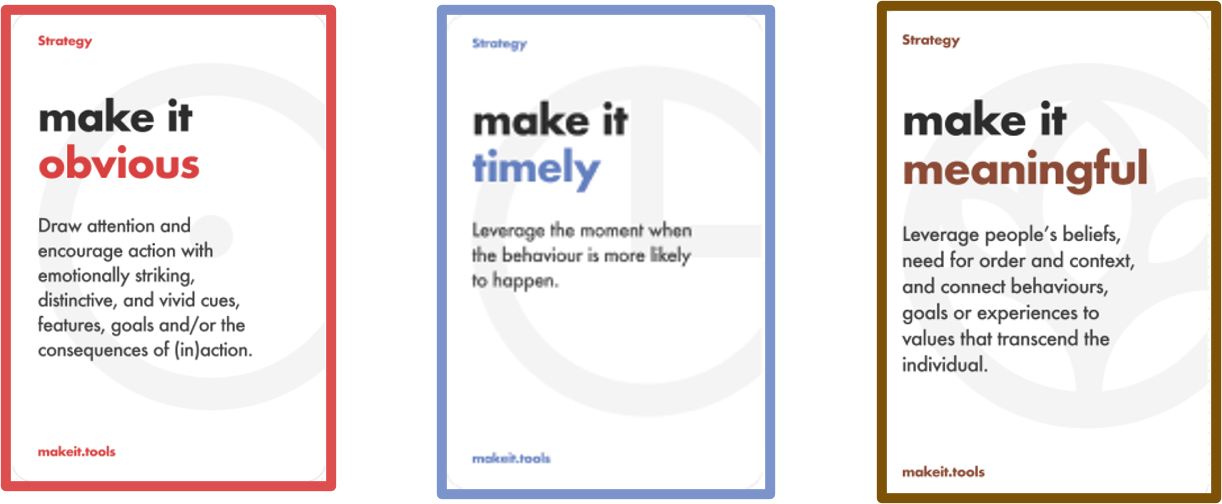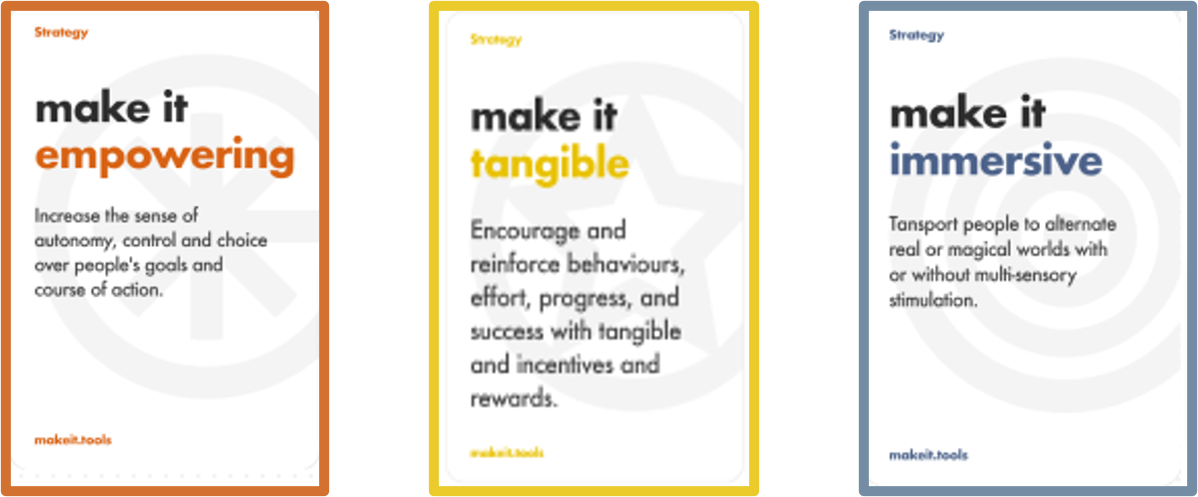Augmenting the ADKAR Model with makeit Behavioral Design Strategies
The Prosci ADKAR® Model is a widely used change management framework because it provides a simple, easy-to-understand framework that can be applied to any type of change initiative. It helps managers and change leaders to diagnose resistance, identify gaps, and effectively support individuals through the transformation process, ensuring a smoother transition and a higher likelihood of long-term success.
ADKAR MODEL + Makeit toolkit
In this blog post, we’ll first introduce the ADKAR® Model and then utilize a simple CASE STUDY, introducing Gen AI to an Organization, to introduce how the Make It Toolkit for Behavioral Design and Change Management might be leveraged to support change management planning.
What is the ADKAR Model?
The ADKAR® Model is a goal-oriented change management framework that helps individuals and organizations navigate and implement change successfully. It focuses on achieving five key outcomes:
(1) Awareness of the need for change. Ensuring that individuals understand why change is necessary.
Goal: To communicate the reasons behind the change effectively, highlighting the risks of not changing and the benefits of the proposed change.
Factors influencing the degree to which people internalize awareness messages:
Trust in leadership and source credibility
Clarity and simplicity of the message
Relevance to individual roles and impact
Emotional connection and storytelling
Timely communication and context
Alignment with past experiences and beliefs
Openness to change and personal motivation
(2) Desire to participate and support the change. Creating a willingness among individuals to support and engage in the change.
Goal: To build intrinsic and extrinsic motivation for change by aligning it with personal and organizational goals.
Factors influencing people’s desire to participate or support the change:
Perceived personal benefits
Trust in leadership
Emotional alignment
Peer influence and social proof
Minimization of personal risk
Clarity of the vision for the future
Opportunity for involvement and input
(3) Knowledge on how to change. Providing the necessary information and training for individuals to know how to change.
Goal: To ensure everyone involved has a clear understanding of what is required for the change, including processes, tools, and behaviors.
Factors influencing the degree to which individuals can build the requisite knowledge or ability required to implement the change:
Quality of training and education
Access to resources and support
Learning styles and preferences
Time and capacity for learning
Opportunities for practical application
Feedback and coaching
Employee motivation and willingness to learn
(4) Ability to implement the change. Developing the skills and capabilities required to implement the change successfully.
Goal: To equip individuals with the practical skills needed to execute the change, overcoming potential barriers and challenges.
Factors influencing the degree to which people can develop the skills and capabilities required to implement the change successfully:
Hands-on practice opportunities
Access to ongoing support and coaching
Availability of tools and resources
Quality of feedback mechanisms
Repetition and reinforcement
Psychological safety and environment for learning
Personal motivation and commitment
(5) Reinforcement to sustain the change. Establishing mechanisms to ensure the change is maintained over time.
Goal: To embed the change into the organizational culture and processes, making it a lasting part of the organization's operations.
Factors influencing the degree to which people can sustain the change:
Continuous reinforcement and recognition
Ongoing support and resources
Integration into existing processes
Monitoring and accountability
Leadership commitment and visibility
Cultural alignment
Adaptability and flexibility
Given the behavioral change aspect of the Prosci ADKAR® Model it only makes sense that the fifteen (15) core behavioral design strategies would serve as a useful companion to any change management practitioner.
How Do I Use ADKAR to support Generative AI Change in an Organization?
EXAMPLE CASE STUDY - Introducing Generative AI into an Organization
For the purposes of this blog post, let’s take a simple example of seeking to introduce Generative AI (GenAI) into an organization:
(1) Employee resistance and fear of job displacement: Employees may resist AI adoption due to concerns about job loss and career impact.
(2) Skill gaps and training needs: A lack of required skills and knowledge could hinder employees from effectively using and managing AI.
(3) Data quality and availability: Insufficient or poor-quality data can limit the effectiveness and reliability of Generative AI outputs.
(4) Ethical and bias concerns: Generative AI can perpetuate bias or generate unethical outputs, leading to trust and fairness issues.
(5) Integration with existing systems: Integrating AI into legacy systems and processes can be technically challenging and disruptive.
(6) Cost of implementation and maintenance: High upfront costs and ongoing maintenance can pose financial challenges for adopting Generative AI.
(7) Security and privacy risks: AI implementation can expose the organization to new security vulnerabilities and privacy concerns.
How might the different makeit behavioral design Strategies be leveraged in our change management planning?
How can the Make it Strategies increase Awareness?
This step involves understanding why change is necessary. It's crucial for individuals to recognize the importance of the change and its impact on the organization and themselves.
ADKAR - AWARENESS (makeit obvious, timely, and meaningful)
A few simple examples:
Makeit Obvious: Use clear, compelling communications to highlight the importance and benefits of GenAI. Create awareness through emails, presentations, and meetings that explain why the change is necessary.
Makeit Timely: Introduce the concept of GenAI at a strategic moment, such as during annual planning or after a notable challenge where GenAI could have offered solutions.
Makeit Meaningful: Connect the introduction of GenAI to organizational values like innovation, efficiency, or customer satisfaction, making it relevant and important.
How can the Make it Strategies Create Desire?
Desire refers to the personal motivation to support the change. This is influenced by personal factors, such as an individual's personal situation, the perceived benefits of the change, and organizational factors like the overall climate and culture.
ADKAR DESIRE (Makeit attractive, social, and yours)
A few simple examples:
Makeit Attractive: Frame GenAI as a positive change that will bring significant benefits, such as reducing workload, enhancing capabilities, and offering new professional development opportunities.
Makeit Social: Leverage social proof by sharing testimonials and endorsements from respected leaders and early adopters within the organization.
Makeit Yours: Involve employees in discussions about how GenAI can be tailored to meet their specific needs and improve their work outcomes, increasing their personal investment in the change.
How can the Make it Strategies impact Knowledge to Change?
Knowledge entails knowing how to change, including the skills and behaviors required during the transition. Training and education are critical components in this phase to ensure everyone knows what to do and how to do it.
ADKAR MODEL (Makeit easy, achievable, intriguing)
A few simple examples:
Makeit Easy: Provide straightforward, easily accessible training and resources to educate employees on how to use GenAI tools effectively.
Makeit Achievable: Break down training into manageable steps, ensuring that employees feel confident in their ability to master the new technology.
Makeit Intriguing: Keep training engaging by incorporating interesting, real-world examples of how GenAI can solve complex problems or create new opportunities.
How can the Make it Strategies Help Turn Knowledge Into Aciont (Ability)?
Ability is about turning knowledge into action. It involves the actual performance and ability to change, often requiring ongoing support and corrections as individuals try new processes or tools.
ADKAR Model (makeit empowering, tangible, immersive)
A few simple examples:
Makeit Empowering: Give employees control over how they integrate GenAI into their workflows, allowing them to discover and utilize features that are most relevant to their roles.
Makeit Tangible: Set up pilot projects or trials where employees can see direct results from their use of GenAI, providing practical experience and building competence.
Makeit Immersive: Use simulations or immersive learning environments to allow employees to practice with GenAI in a controlled, supportive setting.
How can the Make it Strategies Help Reinforce OR sustain the change
The final stage involves mechanisms that reinforce and make the change stick. This can include positive feedback, rewards, and finding ways to institutionalize the change through policies and norms.
ADKAR MOdel (makeit timely, tangible, unexpected)
A few simple examples:
Makeit Timely: Offer continuous support and follow-up training at key moments after the initial rollout to reinforce learning and correct any misuse of the technology.
Makeit Tangible: Recognize and reward departments or individuals who effectively adopt and advocate for GenAI, turning their successes into a model for others.
Makeit Unexpected: Surprise employees with new updates, features, or additional support for GenAI use that exceeds their expectations and keeps the technology fresh and engaging.
Using the "Makeit Strategies" in tandem with the ADKAR Model not only addresses the technical and practical aspects of introducing GenAI but also aligns with the psychological and social dynamics that influence how change is perceived and adopted in an organization. This dual approach helps ensure a smoother transition and more successful implementation of GenAI across all levels of the organization.
Reach out and book a call if you wish to learn more about the makeit toolkit and how to apply it your own changement management initiative.
P.S. If you liked this post, please give it a share, or a simple comment. Insightful 💡or Love ❤️ it!







